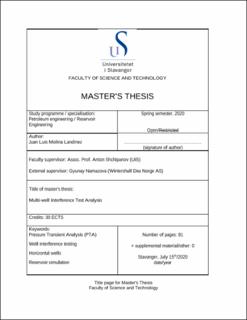| dc.contributor.advisor | Shchipanov, Anton | |
| dc.contributor.advisor | Namazova, Gyunay | |
| dc.contributor.author | Molina Landinez, Juan Luis | |
| dc.date.accessioned | 2020-10-27T14:47:13Z | |
| dc.date.available | 2020-10-27T14:47:13Z | |
| dc.date.issued | 2020 | |
| dc.identifier.uri | https://hdl.handle.net/11250/2685344 | |
| dc.description | Master's thesis in Petroleum engineering | en_US |
| dc.description.abstract | Understanding if there is any hydraulic communication, between the wells within a reservoir and a degree of the communication have been a subject of study for a long time. This information becomes crucial when injection schemes are implemented in the oil and gas fields to mobilize the reservoir fluids or support pressure. Interwell tracer tests and interference tests using pressure data are some of the existing methods to determine the hydraulic connectivity between adjacent wells.
The objective of this work is to identify and characterize the reservoir communication between the horizontal producers and production-injection wells using data from one of the oil fields on the Norwegian Continental Shelf. The reservoir in focus is a fault block, limited by sealing faults from sides making well interference of special importance for improving drainage strategy and sweep efficiency. The objective above is achieved by analyzing the pressure transient data collected by permanent downhole gauges in combination with rates.
Conventional interference test interpretations, that use the exponential integral solution approximation, are not used in this study because of the relative short distance between the wells compared to their long horizontal well section, and the interference with the outer reservoir boundaries and/or with the nearby wells that prevented the late pseudo-radial flow from developing at the late time region. Analysis with time-lapse shut-in pressure transients using analytical, and numerical models are carried out instead, to evaluate well interference for the horizontal production wells and the deviated injection well. Additionally, time-lapse Pressure Transient Analysis (PTA) is implemented to evaluate the changes along the time in the well and reservoir parameters.
The PTA using analytical and numerical models showed similar results and both confirmed the well interference between the producers as well as between the producers and the injector. Time-lapse PTA with analytical models has confirmed strong interference between the producers. It was found that interference with wells in production may be similar to wells in shut-in, if these wells significantly depleted pressure in the drainage area before this shut-in.
As a next step, numerical models were applied to address the complex reservoir geometry and the horizontal wells, as analytical models consider the horizontal wells nearby the tested well as vertical wells and the closed system by a rectangular shape. From time-lapse PTA analysis, different behavior in the pressure response in the southern part of the field is obtained before and after water injection. Reservoir heterogeneity is observed in this part of the field having higher kh compared to the northern part of the field, but during injection further increase of kh may be interpreted. Multi-layer model and sensitivity analysis suggested that the apparent increase in kh after waterflooding is the result of a contribution of an additional layer. This can be explained by activation of some portions within the same main producing layer or an underlaying layer.
The study confirmed capabilities of time-lapse PTA with analytical models to get understanding of interference for long horizontal wells in fault block type of reservoirs. Analytical models are fast in assembling and running, while simplified well and reservoir geometries are capable to capture major pressure behavior in such reservoirs. The well and reservoir parameters from the analytical models were further applied in numerical models giving same quality history match, providing the basis for further study of more complex effects. | en_US |
| dc.language.iso | eng | en_US |
| dc.publisher | University of Stavanger, Norway | en_US |
| dc.relation.ispartofseries | Masteroppgave/UIS-TN-IEP/2020; | |
| dc.rights | Navngivelse 4.0 Internasjonal | * |
| dc.rights.uri | http://creativecommons.org/licenses/by/4.0/deed.no | * |
| dc.subject | petroleumsteknologi | en_US |
| dc.subject | petroleum engineering | en_US |
| dc.subject | reservoarteknologi | en_US |
| dc.subject | pressure transient analysis | en_US |
| dc.subject | well interference testing | en_US |
| dc.subject | horizontal wells | en_US |
| dc.subject | reservoir simulation | en_US |
| dc.title | Multi-well Interference Test Analysis | en_US |
| dc.type | Master thesis | en_US |
| dc.subject.nsi | VDP::Teknologi: 500::Berg‑ og petroleumsfag: 510::Petroleumsteknologi: 512 | en_US |

